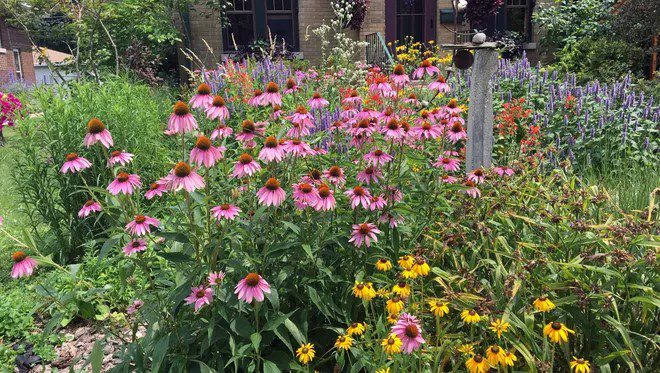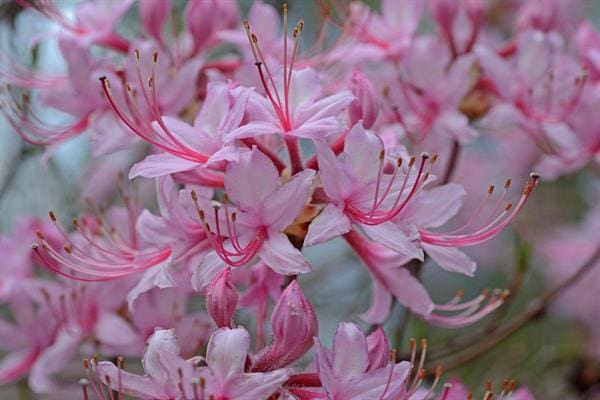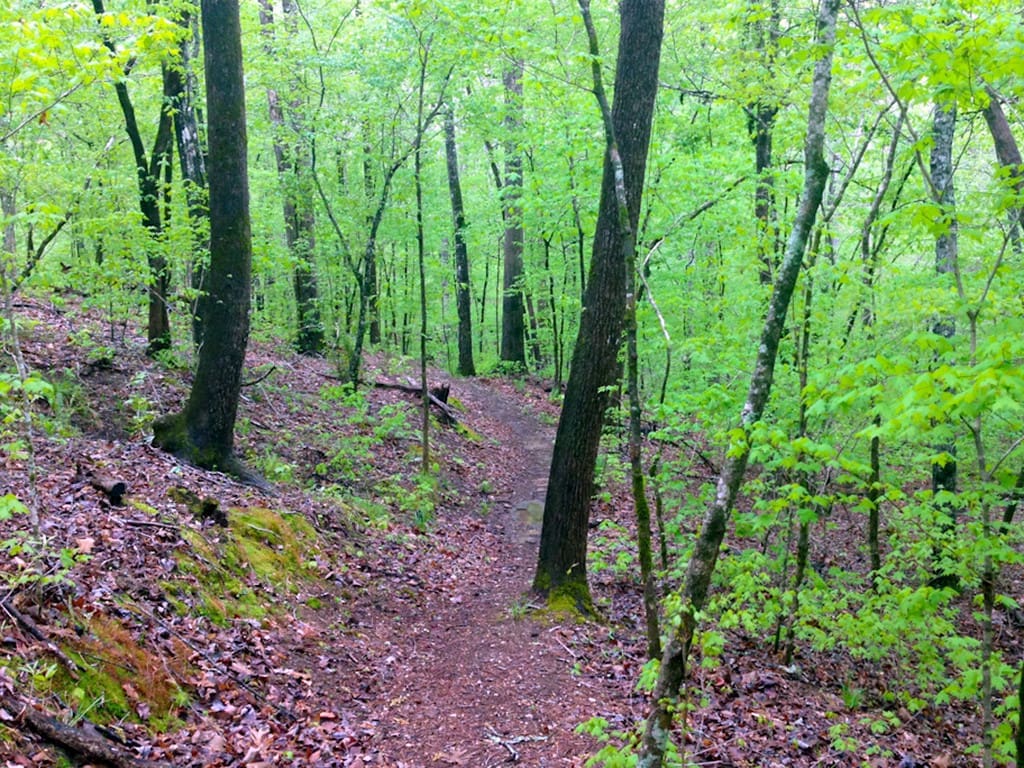by Chuck Hubbuch
Historical Background of Piedmont Prairies
Early European settlers in the Piedmont region of the Carolinas reported seeing numerous prairies and open, grassy woodlands. While some of the grasslands are attributed to shallow soils, fire and large herbivores like American bison and elk are credited with creating and maintaining many of these open areas. Native plants and animals adapted to and came to depend on prairies. In modern times, development, agriculture, invasive exotics and fire suppression contribute to a great reduction of prairies in our state. As a result, several native prairie species are now rare or threatened with extinction.
The Artificial Prairie: American Lawns
A typical American lawn is, in effect, an artificial prairie that requires a high level of maintenance, has very low plant diversity and supports very little wildlife. Some ecologists have compared lawns to deserts but that comparison is insulting to deserts which can be much more biologically diverse and interesting. Converting a lawn – or part of it – to a short prairie could add a lot of color and life to a yard. Instead of burning or introducing bison to a suburban prairie, it can be maintained with traditional garden methods of weeding and trimming. Pocket prairie is one term that is used for a small garden of prairie plants.
Design Considerations for Suburban Prairies
Choosing Prairie Plants for Large Spaces
For a large space, tall prairie plants like ironweed (Vernonia spp.), sunflowers (Helianthus spp.), and big bluestem (Andropogon gerardii) may be appropriate. Broadcasting native grass and wildflower seeds allows the seedlings to establish themselves naturally, providing an authentic prairie look.
Adapting Prairie Designs for Suburban Settings
In suburban settings, the fully natural look of a tall grass prairie may not be appropriate due to aesthetic or management considerations. Here, the shorter plants of a short grass prairie, such as little bluestem (Schizachyrium scoparium), blazing star (Liatris spicata), butterfly milkweed (Asclepias tuberosa), coneflowers (Echinacea spp.), and short species of goldenrod (Solidago spp.) and aster (Aster spp.), may be a better fit. These can be planted in a natural or formal design depending on the desired appearance and maintenance level.
Creating Pocket Prairies in Smaller or Formal Gardens
An informal pocket prairie can resemble an English garden with a South Carolina twist. To achieve this, plant in beds with clearly defined edges. Include garden elements such as paths, walls, seating, low fencing, trellises, and water features if space allows. Large containers can be used to feature special plants, provide special growing conditions, protect plants from rabbits and human feet, and add color. These touches contribute to a more domestic appearance, which can be more acceptable to neighbors.
Incorporating Formality and Functionality
If formality is important in your garden design, consider planting your wildflowers in beds of discrete groups. This helps maintain a tidy appearance while still embracing the prairie style. Several flowering prairie species are available at SCNPS native plant sales and may be found in commercial nurseries with a little searching. Where space and homeowner associations permit, consider planting grasses and sedges in naturalistic swathes. Scatter wildflowers through the grasses, repeating at least a few species throughout to help tie the design together and create visual continuity.
Adapting Prairie Plants to Shaded Areas
Full sun is helpful but not necessary. Shade tolerant grasses include upland river oats (Chasmanthium latifolium), purpletop tridens (Tridens flavus), bottlebrush (Elymus hystrix), and Virginia wildoats (Elymus virginicus). Several native, shade-tolerant sedges are now available from SCNPS plant sales and online mail order nurseries. Many native wildflowers flower well in part shade. In addition to their visual interest, these prairie plants will attract a wide variety of wildlife. In particular, a prairie can host buckeye, wood nymph, satyr, fritillary, and monarch butterflies – and a variety of skippers. Their caterpillars and other insects will attract a diverse group of birds. The seeds of plants like native sunflowers, coneflowers, and blazing star attract native finches, sparrows, doves, juncos, and other birds. Lightning bugs, too, prefer unmowed plantings and leafy mulches.
Supporting Rare Prairie Species through Suburban Gardens
Rare prairie wildflowers of upstate South Carolina include smooth coneflower (Echinacea laevigata), Schweinitz’s sunflower (Helianthus schweinitzii), and Georgia aster (Symphyotrichum georgianum). Growing these plants in gardens in their native ranges does not take the place of conservation in their natural habitats but it may make a contribution to their continued existence – and that of their pollinators.
Deer Resistance in Suburban Prairies
A few shrubs are appropriate for pocket prairies. Low-growing forms of fragrant sumac (Rhus aromatica), black aronia (Aronia melanocarpa), Georgia savory (Clinopodium georgianum), and shrubby St. Johnswort (Hypericum prolificum) are appropriate for sites with some sun. Yellowroot (Xanthorhiza simplicissima) grows in shady spots. Once established, medium-sized shrubs like fragrant sumac and beautyberry (Callicarpa americana) can be cut back aggressively each year to keep the plants short. Deer are problems in the yards of many upstate neighborhoods. While they will eat anything if they are hungry enough, deer prefer to browse the leafy twigs of broad-leafed plants. Typically, they leave grasses and sedges alone. Adding wildflowers that deer tend to avoid will make a pocket prairie reasonably resistant to deer predation.
Building Your Suburban Prairie: Plant Recommendations
Following is a list of some short, fairly deer resistant plants that you can use in creating your own suburban short grass prairie.
Grasses
- Agrostis hyemalis – Winter bent grass
- Andropogon ternarius – Splitbeard bluestem, especially dwarf selections like ‘Black Mountain’
- Chasmanthium latifolium – Inland sea oats
- Chasmanthium laxum – Slender wood oats
- Danthonia spicata – Poverty oatgrass
- Elymus virginicus – Virginia wildoats
- Eragrostis spectabilis – Purple lovegrass
- Festuca subverticillata – Nodding fescue
- Panicum virgatum – Switchgrass, especially dwarf selections like ‘Cheyenne Sky’
- Piptochaetium avenaceum – Blackseed needle grass
- Sorgastrum elliottii – Nodding Indian grass
- Tridens flavus – Purpletop tridens
Sedges
- Carex appalachica – Appalachian sedge
- Carex cherokeensis – Cherokee sedge
- Carex laxiculmis – Creeping sedge
Wildflowers
- Achillea gracilis – Eastern yarrow
- Allium cernuum – Nodding onion
- Asclepias tuberosa – Butterfly milkweed
- Asclepias verticillata – Whorled milkweed
- Baptisia australis – Blue false indigo, especially the dwarf form, ‘Minor’ or var. minor
- Chamaecrista fasciculata – Partridge pea
- Chrysogonum repens – Green-and-gold
- Chrysopsis mariana – Maryland golden aster
- Clinopodium georgianum – Georgia savory
- Clitoria mariana – Butterfly pea
- Coreopsis lanceolata – Lance-leaf coreopsis
- Coreopsis pubescens – Star tickseed
- Echinacea purpurea – Purple coneflower
- Erigeron pulchellus – Robin’s plantain
- Eryngium yuccifolium – Rattlesnake master
- Eupatorium album – White thoroughwort
- Euphorbia corollata – Flowering spurge
- Hypericum hypericoides – St. Andrew’s cross
- Hypericum prolificum – Shrubby St. Johnswort
- Liatris spicata – Dense blazing star
- Lobelia puberula – Downy lobelia
- Manfreda virginica – False aloe
- Marshallia obovata – Piedmont Barbara’s buttons
- Monarda punctata – Dotted beebalm
- Parthenium integrifolium – Wild quinine
- Penstemon digitalis – Foxglove beardtongue
- Pityopsis aspera – Grassleaf silkgrass
- Pycnanthemum tenuifolium – Narrowleaf mountain mint
- Rudbeckia hirta – Black-eyed Susan
- Salvia lyrata – Lyre-leaf sage
- Scutellaria incana – Downy skullcap
- Symphyotrichum georgianum – Georgia aster
- Tephrosia virginiana – Goat’s rue
Perennial Groundcovers
- Fragaria virginiana – Wild strawberry
Shrubs
- Yucca flaccida – Weakleaf yucca
Conclusion: Embracing Biodiversity in Suburban Landscaping
As we strive to create sustainable and ecologically diverse environments within our suburban landscapes, the incorporation of native prairie plants offers a promising solution. Not only do these plants contribute to the restoration of lost habitats and the preservation of native species, but they also enhance the beauty and functionality of our yards.
By cultivating prairie gardens, we not only create vibrant havens for pollinators, birds, and other wildlife but also foster a deeper connection to the natural world. As stewards of our land, let us embrace the opportunity to transform our suburban spaces into thriving ecosystems, where native plants and animals can flourish alongside us.




